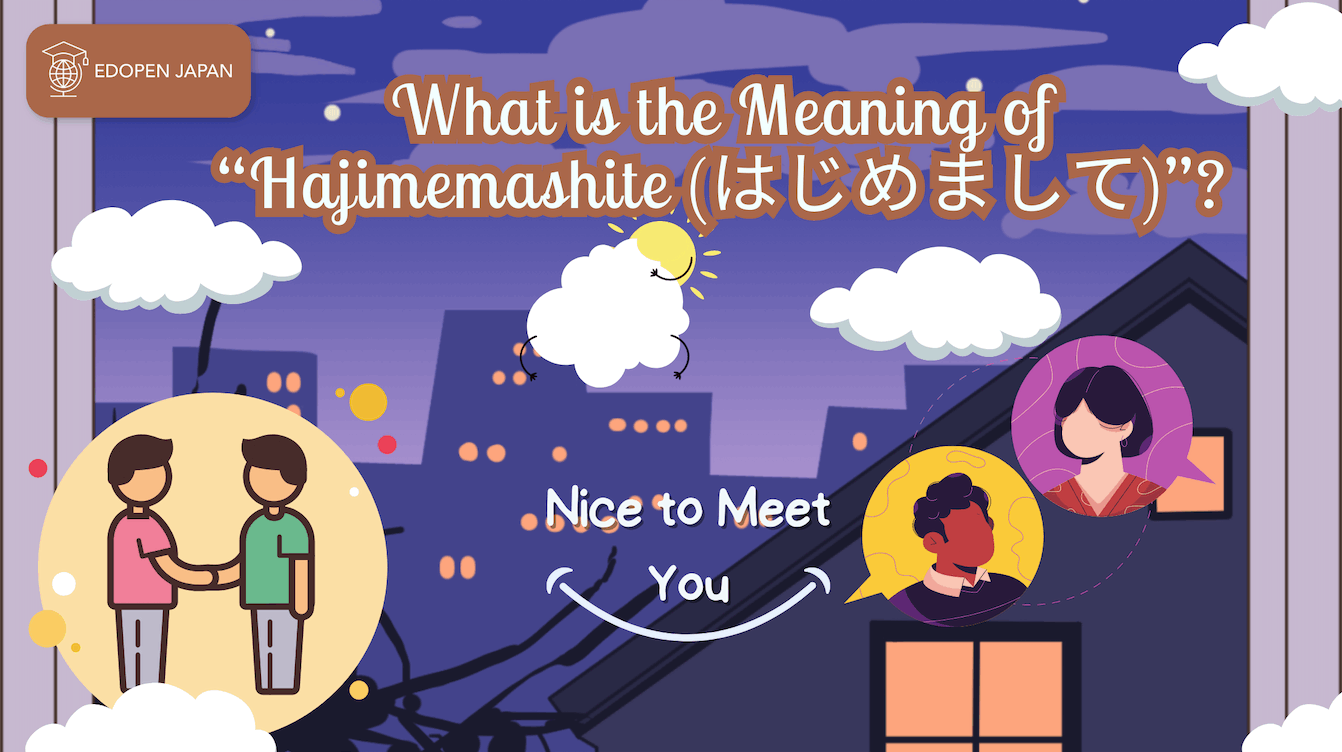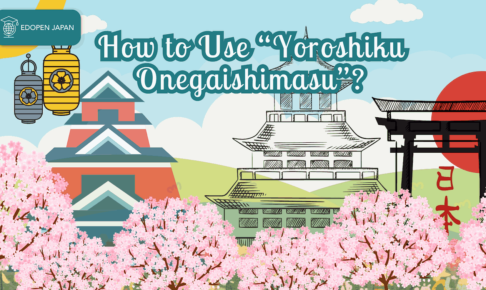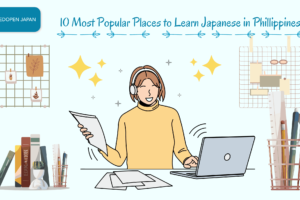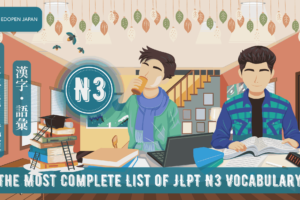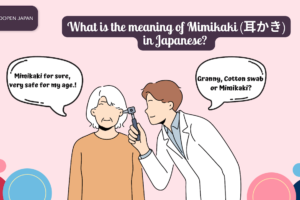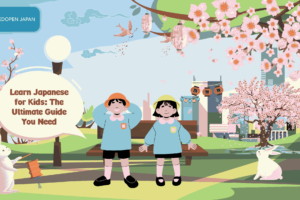Hello and Hajimemashite. Hajimemashite’, along with many other common greetings such as ‘Konichiwa’ or ‘Yoroshiku’, are commonly heard and used in everyday conversations here in Japan.
Despite its common use and familiarity in everyday Japanese conversation, many people still do not know the meaning and usage of this term. In this article, we will go over the meaning of “hajimemashite” and when to use it in everyday conversation. Let’s go over the meaning of “Hajimemashite” first.
In addition, if you are currently learning other phrases or vocabulary that are also popular in everyday Japanese conversation but are confusing you, please also read our recommended articles below:
Read also:
How Hard is it to Learn Japanese?
What’s the Meaning of “Sasuga” (さすが)
What’s the Meaning of “Naruhodo (なるほど)”?
Contents
1. The Meaning of ‘Hajimemashite’
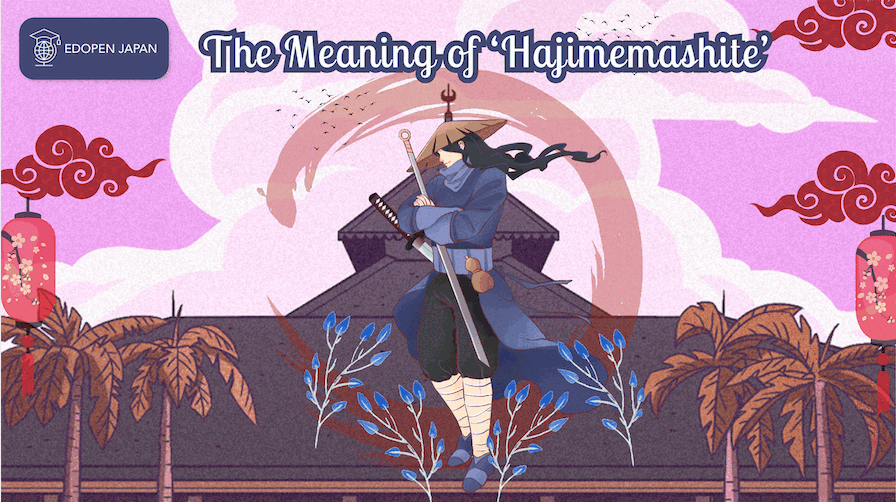
Many know ‘Hajimemashite’ as ‘Nice to meet you’. However, hjime’ in English has different meanings depending on the kanji used.
- Haji (初) me(め)
This kanji is used to signify the beginning. The beginning in time sense. Often used to imply ‘for the first time’ - Haji (始) me(め)
This kanji is used to signify the start. The start of an action. To indicate an initiation to something or the start in doing something such as starting a race.
These two can be incredibly confusing, but the first kanji (the one with the dagger) often means time, while the other (the one with the girl) often means action. Together, however, they indicate a start or a beginning.
Hajimemashite’ means nice to meet you for the first time. Therefore, when we greet each other with ‘Hajimemashite (初めまして)’, the dagger kanji is used. In other words, “Hajimemashite” means “Pleased to meet you for the first time“. It is interesting that such short words say so much.
2. When to Use ‘Hajimemashite’?

Now that we are fairly familiar with the meaning of “Hajimemashite”, let’s discuss when we use “Hajimemashite” in our daily conversations.
- 1st time meetings:
‘Hajimemashite’ is often used for meeting someone you do not know of at all, for the very first time. - Self-Introduction:
Apart from using ‘Hajimemashite’ for first meetings, this greeting term is often used for self-introductions. For example, in a self-introduction during a job interview or a family gathering for the first time. - In response to a greeting:
‘Hajimemashite’ can also be used in response to the other party’s greeting. Signifying it is nice to meet you too. - Asking about someone’s whereabouts:
‘Hajimemshite’ can also be used to ask, ‘How do you do?’ or ‘How are you?’ - Initiating a start of an acquaintanceship:
‘Hajimemashite’ is also used to signify the start of an acquaintanceship. It shows that the speaker is pleased to be acquainted with the listener. Initiating the beginning of a bond. - Used as a combination:
‘Hajimemashite’ can be also used to show a combination of any of the above. For example, to ask how you are and to show the start of an acquaintanceship with a co-worker at a new workplace.
Unlike many casual greetings, ‘Hajimemashite’ can only be used once, and cannot be used over and over again to greet the same person. We do not repeatedly say ‘Nice to meet you for the first time’ to our friends whom we have known for a while. That would be a bit unusual, wouldn’t it?
Hajimemashite’ seems short and quick, but polite in its form. It can be used in the workplace among colleagues or with neighbors meeting for the first time. It can also be used when addressing seniors in age and position. Simple but polite.
3. ‘Hajimemashite (はじめまして)’ VS ‘Hajimemashita (はじめました)’

Which brings us to our next point. A common question.
What is the difference between ‘Hajimemashite’ and ‘Hajimemashita’?
The verb form of ‘Hajime’ is ‘Hajime(ru)’, which would mean to start or begin something.
Hajimemashita’ in the greeting setting is often the much more formal way of addressing ‘Hajimemashite’. However, ‘Hajimemashita’ can often have other meanings, so ‘Hajimemashite’ is generally used as a greeting.
Hajimemashita’ is often used to show the past tense of starting an action. For example, I started to eat rice. Hajimemashita’ would be used to accompany the verb ‘to eat’ in this sentence. Therefore, the confusion tends to make ‘Hajimemashite’ an easier and more commonly used greeting for meetings.
Accompanying Words
When “Hajimemashite” is used as a greeting, it is often not accompanied by a verb or action. Although it is not accompanied by a verb, “Hajimemashite” is accompanied by another greeting. We are sure many of you are familiar with this greeting.
It is none other than ‘Yoroshiku Onegaishimasu (よろしく おねがいします)’.
It is not uncommon for many to use “Yoroshiku Onegaishimasu” or “Yoroshiku” after using “Hajimemashite”. Yoroshiku’ is used after ‘Hajimemashite’ to convey the meaning of ‘please take care of me’ or ‘please treat me kindly’. It is intended to show a favorable first meeting and impression, the beginning of a relationship on good terms.
If you hear this combination in any setting, do not be alarmed, it is simply to show more hospitality and formality in first meetings.
Among friends and peers, it is very common to omit this accompanying greeting of ‘Yoroshiku’. However, in a formal business setting, it is preferable to add ‘Yoroshiku Onegaishimasu’ (a formal way of saying ‘Yoroshiku’). After all, you’re going to be working with your colleagues for a while, so you might as well get off to a good start, don’t you think?
An Example
Equipped with the above information, how often will we know which kanji was used in the sentence when we speak? A typical scenario where “Hajimemashite” is used between two strangers meeting for the first time in the neighborhood:
Speaker A: ‘Hajimemashite’ (Pleased to meet you)
Speaker B: ‘Hajimemashite’ (Pleased to be acquainted with you too)
Easy, right? Then, move to a workplace scenario where Speaker A is new to the work environment.
Speaker A:
‘Hajimemashite. Yoroshiku Onegaishimasu’
(Nice to meet you for the first time. Please look after me favorably.)
Speaker B:
‘Kochira koso. Yoroshiku Onegashimasu’
Same here. Pleased to meet you too. Let’s look after each other favorably.
The beauty of these simple examples is that so little is said, but there is so much meaning behind it. Oh, and do we always bow when we use ‘Hajimemashite’? The short answer is yes. It is more polite to bow to show appreciation to both parties.
4. The Synonyms of ‘Hajimemashite’

Finally, are there any synonyms for “Hajimemashite” when greeting each other for the first time?
There is no real replacement for Hajimemashite. Konichiwa’ can be used instead of ‘Hajimemashite’ for first time greetings. However, ‘Konichiwa’ simply means ‘Hi’ and is in a very casual format.
For a much more formal and friendly first impression, especially if you want to show the other party that you want to get to know them, ‘Hajimemashite’ is still the safest choice. Some people would omit ‘Hajimemashite’ and substitute ‘Yoroshiku’, but the meaning is not the same. I hope this helps!
Summary
- Hajimemashite’ means ‘Pleased to meet you for the first time’.
- Often used for first meetings and first introductions.
- Different kanjis used can mean different things, but essentially ‘Hajime’ means the beginning or the beginning.
- Often accompanied by ‘Yoroshiku’ in greetings.
- Can be used in any environment between different age groups and seniority levels.
- Very often accompanied by a bow in greetings.
- A great way to make a first impression and start a new acquaintance!
I hope that when you meet someone for the first time, the term “Hajimemashite” will come to your mind at a convenient time. Yoroshiku Onegaishimasu. See you next time!

